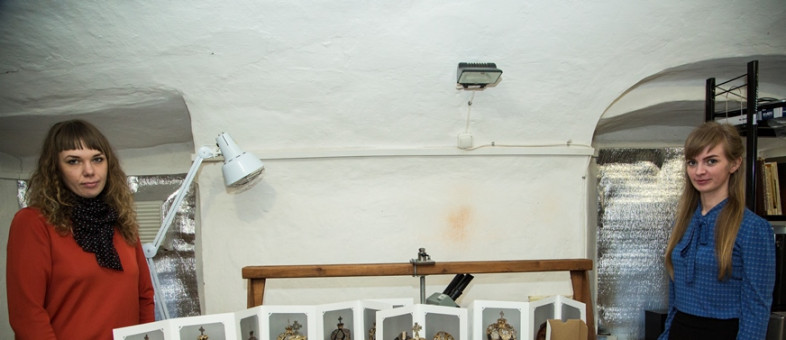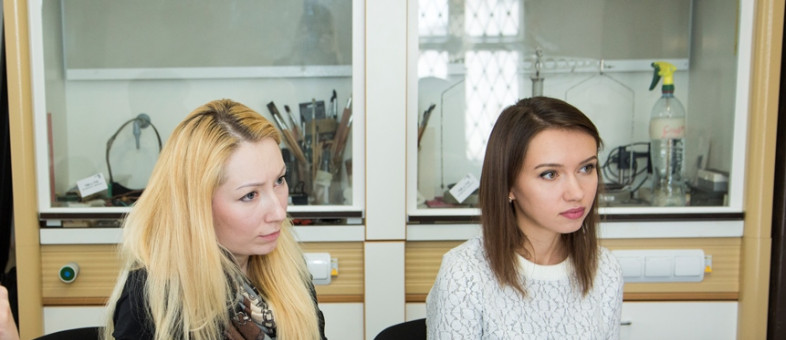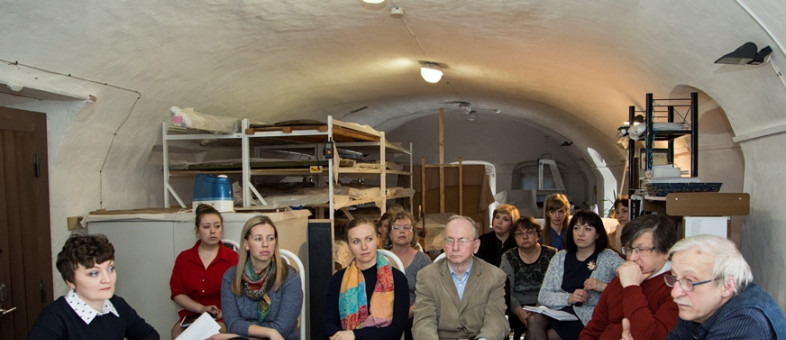Is it easy to restore sanctuary cross?
77 restored articles from the collections of archeology, metal, folk textile, oil painting, Old Russian painting have been returned to the Kirillo-Belozersky Museum-Reserve. All of them have been restored by employees of the Kirillo-Belozersky Museum-Reserve, and two branches of the All-Russian Art Research and Restoration Centre named after Academician I.E. Grabar located in Kostroma and Vologda.
The unique article from the main monastery cathedral that is due to be presented at the exhibition “St. Kirill Belozersky. Rare Iconography Variants” in the People’s House this summer is being restored by specialists of the All-Russian Art Research and Restoration Centre named after Academician I.E. Grabar now. The following issues were discussed at the enlarged meeting of the restoration council that was held in the Kirillo-Belozersky Museum-Reserve on April 17: what stage of work they reached, if everything was successful, what they had to do with painted medallions decorating the sanctuary cross of 1774 to preserve their original and presentable view. Mikhail Sharomazov, director of the Kirillo-Belozersky Museum-Reserve; Nikolay Bregman, leading expert of the department in the State Research Institute for Restoration, restorer of the highest category, member of the attestation commissions on easel and tempera painting and decorative and applied arts, member of the restoration council in the Ministry of Culture of the RF; Margarita Pechikina and Daria Tomilova, restorers of the Vologda’s branch of the All-Russian Art Research and Restoration Centre named after Academician I.E. Grabar, participated in the event.
“The cross has been restored since January 2016. The work is being completed now and we expect that the article will be returned to the museum in the middle of June. They have already restored a wooden base of the cross and a metal silver cover. When they strengthened the paint layer and removed the coating and impurities, the question of further restoration of 22 medallions came up. Opinions of the members of the council of the All-Russian Art Research and Restoration Centre were divided on the methods of these operations. Therefore they suggested that our museum specialists should restore the medallions in the museum”, reported S.N. Smirnova, deputy director on preservation in the Kirillo-Belozersky Museum-Reserve.
The cross decorated with a silver cover is registered in the collection “Precious Metals”. There are different compositions on it, such as “Crucifixion”, “Baptism”, “The Lord Almighty”, “Trinity”, “The Holy Spirit”, “Holy Image of the Saviour Not Made by Hands”, images of saints with scrolls, including the image of St. Kirill Belozersky and other locally venerated saints. All these depictions are located on the metal base and now it is important to decide what to do after their strengthening: to apply restoration prime coat for the lost pieces and to tint them in tune with the surrounding painting, or to leave everything as it is with losses covering it with varnish for preservation.
Each stage of conservation and restoration of this article is verified and discussed. The employees of the Vologda’s branch of the All-Russian Art Research and Restoration Centre named after Academician I.E. Grabar consulted experts of the scientific restoration laboratory of easel oil painting in the State Hermitage to make right decisions for further restoration work and continued conservation and restoration only upon getting their recommendations.
Looking ahead, N.G. Bregman asked the fine art restores of the All-Russian Art Research and Restoration Centre named after Academician I.E. Grabar how they would carry out further restoration of the cross, “What guaranty will we have if the cross is improperly stored?” He noted that the valuables were to be conserved prospectively and suggested that they should take the advice of the colleagues from the Hermitage. M.N. Sharomazov, director of the Kirillo-Belozersky Museum-Reserve is on the same page.
An interesting part of the meeting was return of articles. Two recently restored bridal crowns have been returned to our museum. “They were handed over to the museum in 1938. They come from the Kirillo-Belozersky Monastery. The bridal crowns are made of brass sheet using the embossing technique. They consist of several details connected with rivets. The top in the shape of a crown with a cross is attached with a screw. The details of the bridal crown are visually of different colours: the base is yellow brass; decorative pieces, plates and the cross are black (before restoration). The body of the bridal crowns had numerous deformations, hollows; the tops were very movable because the bolted joint was loose. There were numerous cracks and the surface was covered with a thick layer of dust and organic impurities. The backing cloth wasn’t clean either, had deformations, cracks and stains. The bridal crowns have been restored by Svetlana Georgievna Burshneva and the velvet backing of one crown – by fabric restorer Yulia Sergeevna Maslennikova”, said S.N. Smirnova, deputy director on preservation in the Kirillo-Belozersky Museum-Reserve.
Besides, S.G. Burshneva completed restoration of the articles from the collections “Metal” (a wash-hand-stand was returned to the museum) and “Archeology” (41 items of the main and the scientific auxiliary holdings). She restored the welfare items made of iron and bone (knives, keys, buttons, combs, clips) that had been found by the Onega - Sukhona Expedition of the Institute of Archeology of the Russian Academy of Sciences headed by N.A. Makarov on the grounds of Ancient Beloozero in 1992.
77 restored articles from the collections of archeology, metal, folk textile, oil painting, Old Russian painting have been returned to the Kirillo-Belozersky Museum-Reserve. All of them have been restored by employees of the Kirillo-Belozersky Museum-Reserve, and two branches of the All-Russian Art Research and Restoration Centre named after Academician I.E. Grabar located in Kostroma and Vologda.
Official name of the museum:
The Federal State Budgetary Institution of Culture “Kirillo-Belozersky Historical, Architectural and Art Museum-Reserve”
Founded:
In 1924
Museum status:
It was included into the State List of Particularly Valuable Objects of Cultural Heritage of the Peoples of the Russian Federation in 1997.

 найти на плане
найти на плане



